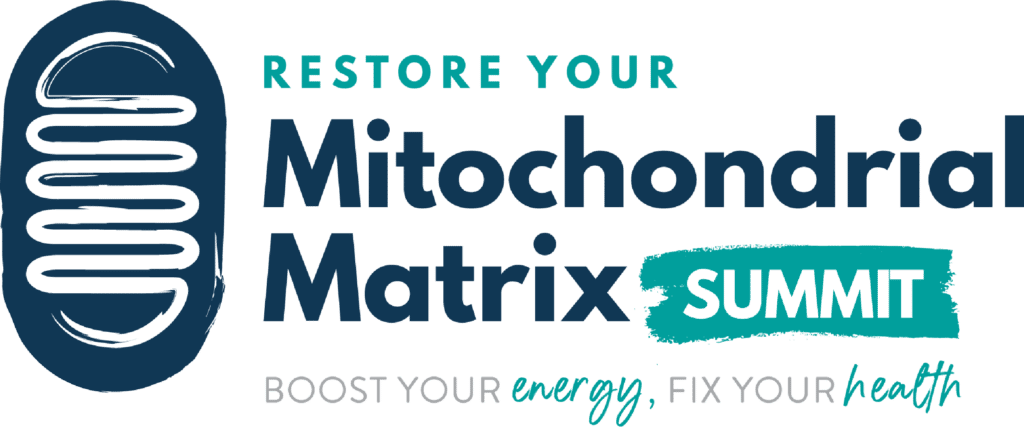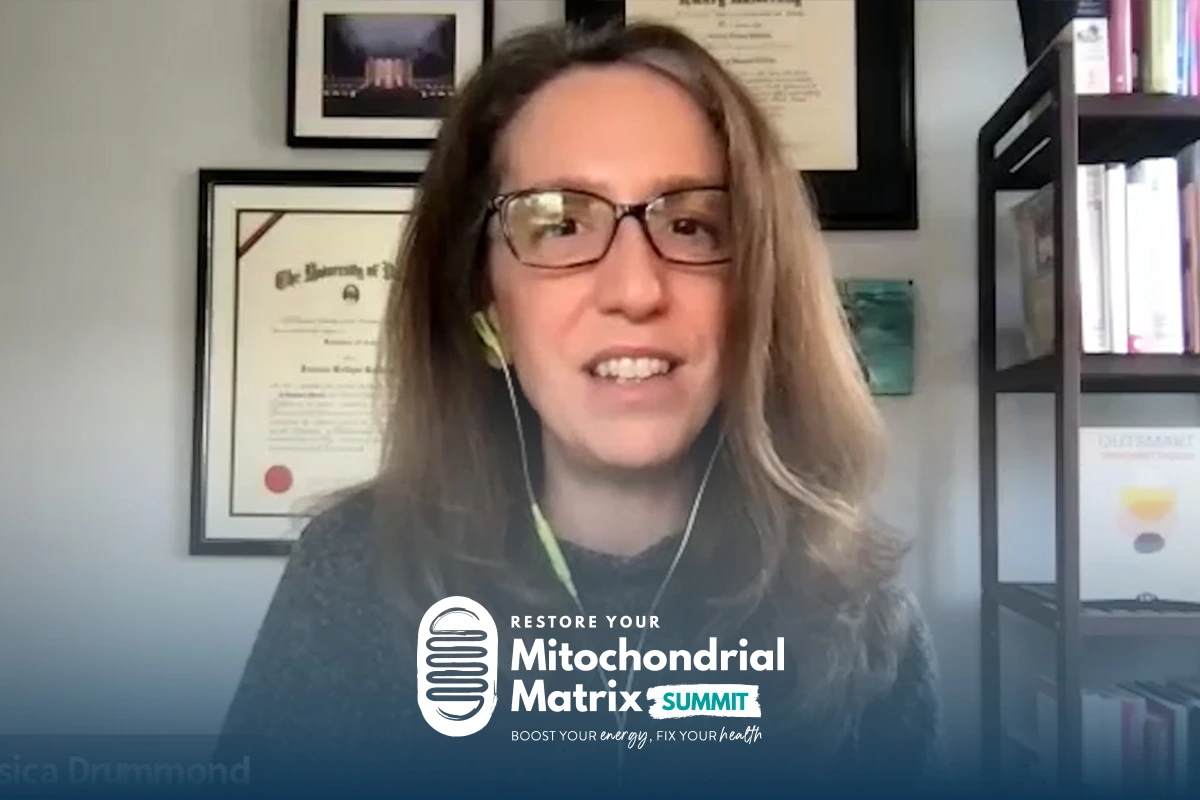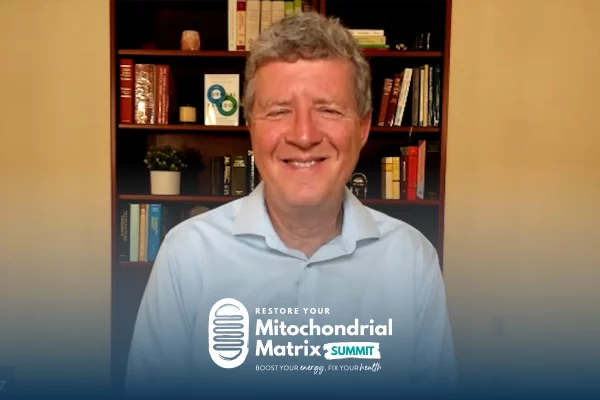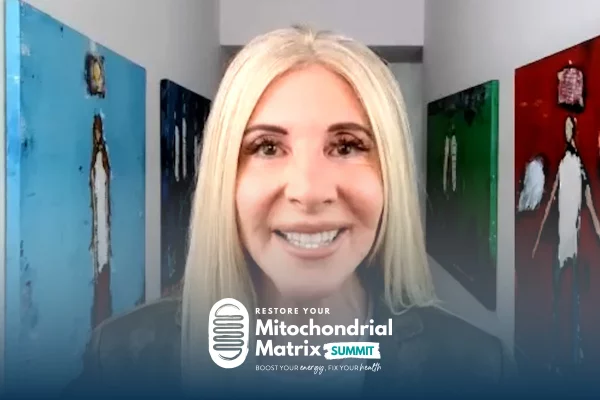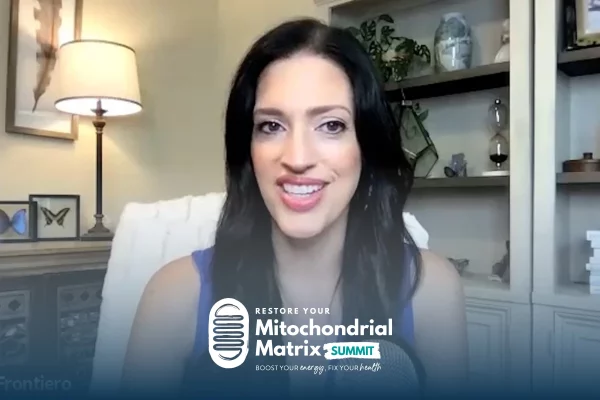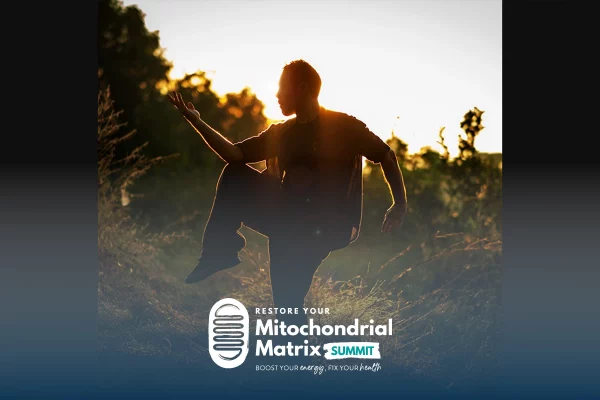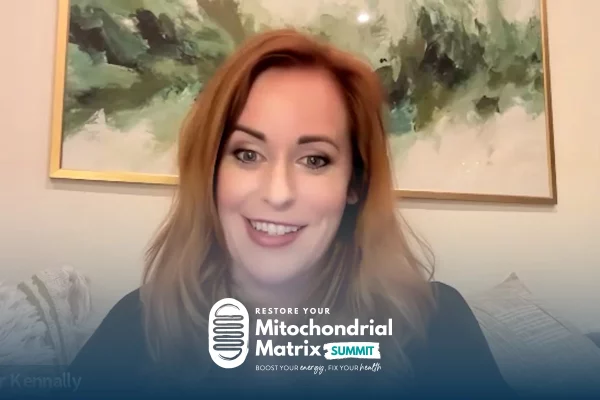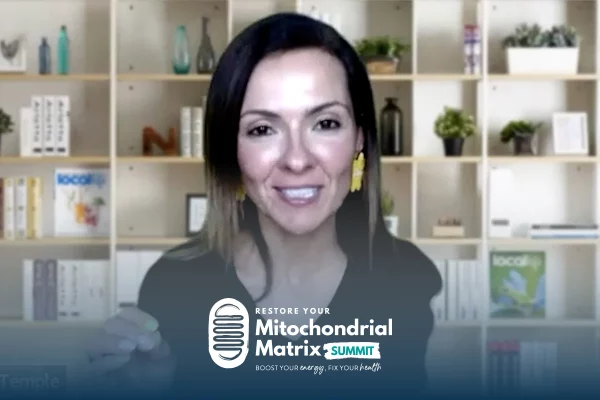Join the discussion below
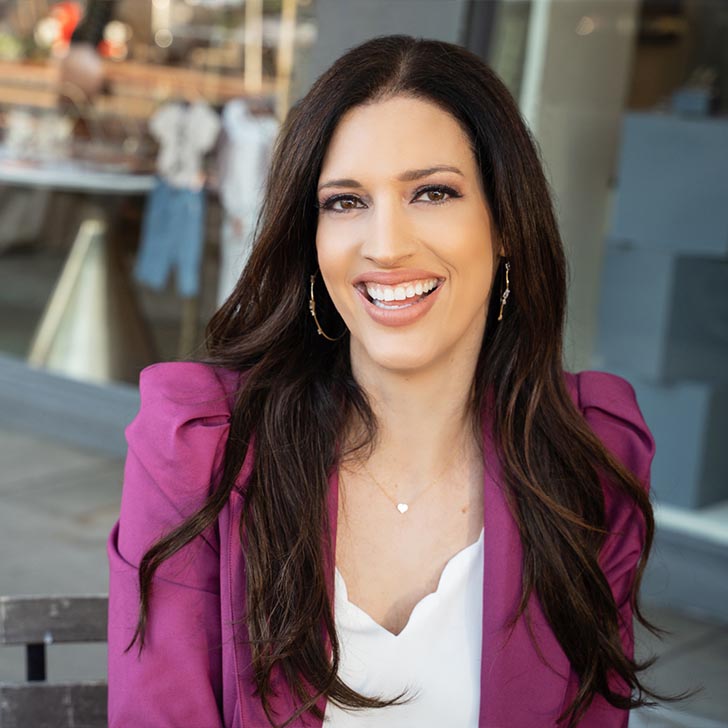
Laura Frontiero, FNP-BC, has served thousands of patients as a Nurse Practitioner over the last 22 years. Her work in the health industry marries both traditional and functional medicine. Laura’s wellness programs help her high-performing clients boost energy, renew mental focus, feel great in their bodies, and be productive again.... Read More
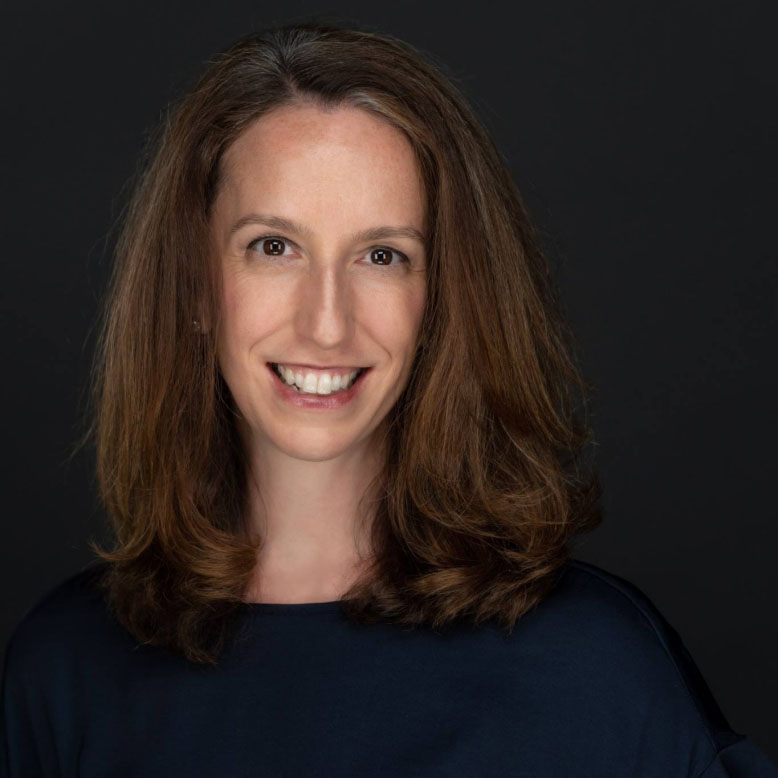
Jessica Drummond, DCN, CNS, PT, NBC-HWC
Dr. Jessica Drummond is the CEO of The Integrative Women’s Health Institute and author of Outsmart Endometriosis. She holds licenses in physical therapy and clinical nutrition and is a board certified health coach. She has 20 years of experience working with women with chronic pelvic pain, facilitates educational programs for... Read More
- Explore how common endometriosis is, the usual symptoms, the link to fatigue and pain, and how mitochondrial support can help with relief.
Laura Frontiero, FNP-BC
You’re watching the Restore Your Mitochondrial Matrix Summit. I’m your host, Laura Frontiero, I’m bringing you experts with fresh ideas and proven methods to help you boost your energy and fix your health so you can build the life you love. And today, my special guest is Dr. Jessica Drummond. Hi, Jessica. Welcome to the Summit.
Jessica Drummond, DCN, CNS, PT, NBC-HWC
Hi, thanks so much for having me.
Laura Frontiero, FNP-BC
Oh, it’s such a pleasure. And I’m really honored to introduce you to our audience. You are the CEO of the Integrative Women’s Health Institute and author of Outsmart Endometriosis. You are also, interestingly, a physical therapist, a clinical nutritionist, and a board certified health coach. You wear a lot of hats, and you have 20 years of experience working with women with chronic pelvic pain. You facilitate educational programs for women’s health professionals all over the world, 60 countries globally. And you have virtual wellness programs for people with endometriosis. Does that about sum it up?
Jessica Drummond, DCN, CNS, PT, NBC-HWC
Yeah, that’s the main, that’s the gist of it, for sure.
Laura Frontiero, FNP-BC
Okay, amazing. Well, today we’re really gonna, we’re gonna jump into how mitochondrial health and endometriosis are connected. And I know we have a lot of practitioners listening, and consumers, patients, clients listening, so everyone wants to know about this. But before we jump into that connection, just tell us a little bit about yourself and how you ended up here, because you sure have a wide background.
Jessica Drummond, DCN, CNS, PT, NBC-HWC
Yes, well, I graduated from, so I was an athlete as a kid, and went into physical therapy, primarily because I was good at science and I liked sports. And, you know, I thought I would be in sports physical therapy. And I did start my career in orthopedic physical therapy back in the late 90s. And then pretty quickly though, I began to specialize in women’s health, which, you know, I had some patients who had more orthopedic related issues, say for example, related to pregnancy, or postpartum, or post breast cancer surgery, things like that. And I became more and more specialized in working with pelvic pain, and pelvic floor dysfunction and bladder issues.
And my most, the most challenging patient population that I worked with, and again, this was back in, you know, the neighborhood of 2006, 2008, 2010, were patients who had chronic pelvic pain often related to endometriosis or another sort of complex chronic illness. And endometriosis has genetic factors, so they could be dealing with this for 12, 15 years before they had good diagnosis. And at the time, you know, we didn’t have a lot of kind of holistic, or even really good Western medicine strategies to address this. So a lot of my patients were struggling with opioid addiction, and had really serious surgical complications and things like that. So, later after I had my first daughter, I struggled with some hormonal health issues of my own, and that introduced me to the world of functional medicine and functional nutrition. And I went back to school and got a doctorate in clinical nutrition and have been really integrating this whole person, you know, whole physiologic systems approach ever since then, so you know, back, well she’s going to college this year, so it’s been a while.
Laura Frontiero, FNP-BC
Right, our kids are growing up. Yes. I have a junior about to be senior, and I don’t know where time went, it’s crazy. But thank you for sharing your unique, interesting journey to where we’re at. Now, with endometriosis, chronic pelvic pain, they kind of go hand in hand, and there’s a connection there between mitochondrial health and the pelvic pain issues. So connect the dots for us there. And then I wanna deep dive into your specialty, which is endometriosis. And we’ll talk about, you know, the symptoms, and the healing and all of it. So, connect those dots for us.
Jessica Drummond, DCN, CNS, PT, NBC-HWC
Yeah, so generally when people think mitochondrial dysfunction, and I think practitioners think about this more than patients who maybe haven’t heard mitochondrial dysfunction at all, but if you’re a practitioner and you’re thinking mitochondrial dysfunction, you’re generally thinking about things like fatigue, low energy, and, or even things like brain fog, lack of focus, because as everyone is aware, you know, listening to this Summit, you’re starting to get, the mitochondria essentially power each and every cell. So if the cells of the brain and nervous system aren’t well powered then there’s going to be fatigue. There’s going to be brain fog issues. There are going to be neurotransmitter issues.
So then you’re gonna have things like anxiety or other sort of mental health challenges. You know, if you’re not, so no matter which cell is underpowered, you’ll have a lack of optimal functioning of that cell. So in my Institute, our founding principle is we don’t chase symptoms, we optimize systems. So, for people with pelvic pain and endometriosis, while that may be the core and more distinctive symptom of what they’re dealing with from a chronic illness standpoint, you know, whether it’s the pain is aligned with their menstrual cycle, or it’s just all the time, or it’s out of the blue, or it flares, you know, and it can be bladder related, it can be digestive related, but no matter, that symptom is sort of a flagship symptom of endometriosis. And not everyone with endometriosis does have intense pain.
There is a wide variety. But people with endometriosis and related chronic pain syndromes also tend to have these other layered symptoms, fatigue, brain fog, insomnia, anxiety, that are less discussed, but just as impactful and problematic for their day to day functioning. And women with endometriosis commonly say, about 74% say that endometriosis takes them off the path of their career development. And because, you know, if you think about it, it presents, you know, you’re in the pre-teen years, and, you know, high school, college, graduate school, when you’re trying to kind of hit those growth milestones academically and in your career, and this takes you off that path. So, people with endometriosis very commonly have mitochondrial dysfunction that makes it difficult for them in terms of struggling also with things like fatigue, insomnia, nervous system, and mental health challenges.
Laura Frontiero, FNP-BC
Wow, wow, so can you dive into, you know, well, let me just back up for a second, Because I work oftentimes with women who are, want to be high producers, want to be really successful in their careers, with their families, with their businesses, entrepreneurs, and their health is taking them out of the game. Their health is preventing them to get to the next level. So, thank you for connecting the dots there and just for saying that, because I think people are hearing that and having some relief right now. Like, oh, it’s not, I’m not, it’s not my fault, there’s not, I’m not, that I’m not smart enough. It’s not that I’m not driven enough. My health is stopping me. So, so thank you for saying that. Now, how com-, let’s talk about how common is this? How common is endometriosis? And how can a person know if they have it? What are the symptoms?
Jessica Drummond, DCN, CNS, PT, NBC-HWC
Well, unfortunately, it’s very common. 10% of people with uterus’ have endometriosis. That’s 176,000,000 people globally. And it presents really at birth. It’s about a, you know, it’s a combination disease in the sense that it’s genetic underpinnings, there are chronic inflammatory underpinnings and there are autoimmune underpinnings. Although that third one is a bit debated in the literature, but I will just say that I believe that that’s the case, and there’s some literature to support that.
Laura Frontiero, FNP-BC
Well, and I’m sure in your clinical practice, and you’ve seen, you know, anecdotally you see women with autoimmune conditions present with this too, and you see it all coming together, right?
Jessica Drummond, DCN, CNS, PT, NBC-HWC
Well, that’s the thing. So, endometriosis itself, it probably has some autoimmune issues and there’s some data to support that. But also people with endometriosis tend to also co-present with things like celiac, and Hashimotos and other common autoimmune diseases, for sure. So, how would you know if you had this? Well, because of that genetic factor, if people in your family, you know, struggled with infertility or painful periods, and this is interesting, because this is sometimes a barrier to treatment, although it’s becoming more comfortable to talk about period pain in the universe.
But at least, and especially in your own home, which is actually extremely recent. You know, up until less than a generation or go, it would be very strange to even really talk about your period pain or your period symptoms with even your mother and your sister. There’s a lot of hush, hush around it. Or like if someone struggled with infertility, which is another super common symptom of endometriosis, and one of, endometriosis is one of the main causes of infertility, you know, that probably wasn’t really discussed generations back. But endometriosis does run in families.
So that’s one risk factor. The sort of presentation classically is someone between roughly eight and 12 years old will present with sort of like chronic IBS or digestive issues that may be cyclical, may not be. So even pre-periods, pre-puberty, there can be some symptoms. But the problem with that is like, you know, if you have a 10 year old girl in sixth, fifth, sixth grade, so many things could cause a kind of general stomach ache, from anxiety to social pressures, to gut dysfunction and things like SIBO and gut dysbiosis also co-present with endometriosis. So, that’s like an early sign, but it’s hardly diagnostic. And then if you layer on top of that when a person’s menstrual cycle begins to get more regular, pretty intense period pain. Like, if you have any period pain, that’s abnormal. But with endometriosis, the period pain in some people is bad but not horrible, but in many people it’s extremely bad to where they have to miss school or work, essentially monthly for at least a day. It’s very commonly for them to have to miss a day or more of school or work or something that they would like to participate in. So, really intense period pain.
And then as I said, fatigue is very common. Brain focusing challenges are very common. It’s interesting though, many of my clients are very driven, and some people have sort of used work, like, they’re very driven, so used work or achieving at school as a way to kind of power through the pain. It sort of helps them distract from the pain. Doesn’t mean they’re not having to miss it sometimes, because they sort of push as hard as they can and then they just can’t anymore, but it’s not uncommon to later on kind of once some of the more intense pain symptoms are more well managed to start to see, oh, well, I actually also am like kind of burnt out at this point, or I really have been dealing with insomnia, but I just was taking, you know, so many things to kind of help myself sleep and mask the pain that I forgot, I don’t really know how to fall asleep without it, you know, or I don’t know how to clear the brain fog.
So, that later can show up. And then collaboratively, bladder pain syndrome, you know, any kind of bladder related pain, urgency, frequency, painful sex is very common. Infertility is very common, or subfertility, or chronic miscarriages. And digestive issues, particularly bloating, which generally speaking is SIBO or SIFO, small intestine bacterial overgrowth or fungal or other microbial overgrowth. But it’s known in the endo community as endo belly. It’s essentially a bloating. But it does tend to have a microbial and kind of peristalsis challenge. ‘Cause if you figure on, in a lot of cases, endometriosis lesions are actually growing on the bowel or the bowel and ovary are adhesed to each other and things like that. So, that can really create the environment for these digestive issues.
Laura Frontiero, FNP-BC
Can you talk about that a little bit? Because I know we have practitioners viewing who understand this, but for person who’s not a practitioner, so what you’re saying is, and I just wanna lay this out for people, is the tissue that should be inside of the uterus at all times is migrating out and it’s growing in places where it shouldn’t be, which is causing a problem.
Jessica Drummond, DCN, CNS, PT, NBC-HWC
Yes, kind of. It’s not actually growing out. It’s not exactly the same tissue as is inside the uterus. It’s similar, but not exactly the same. That’s sort, that’s a sort of old theory that you had this retrograde menstruation, that like your period was flowing out the wrong way from the uterus. That’s not exactly true. But it is true that the lesions, so essentially we think of endometriosis as a non-cancerous cancer. It’s a growth of tissue where it shouldn’t be. And that tissue looks a lot like the tissue that’s inside the lining of the uterus. But by definition, endometriosis is actually outside of the uterus. A similar condition is actually adenomyosis, adenomyosis, which is endometrial like tissue growing in the muscle of the uterus, or somewhere in or around the uterus.
So, endometriosis lesions can be on the ovaries, on the fallopian tubes, outside the uterus, on the bowel, on the bladder, anywhere in the abdominopelvic cavity, on ligaments, or muscles or soft tissue. But also extra pelvic endometriosis, so endometriosis lesions that are on the lung, or the diaphragm, or the knee, or even been found in the nose, is actually not rare. So, this is a systemic disease. And it is related to cancer and can increase some cancer risks, which is why it is really important in many, in most cases to have a true diagnosis of endometriosis to make informed decisions about how you wanna approach your treatment options.
Laura Frontiero, FNP-BC
Right, so I wanna talk about an integrative approach to healing this. Now, obviously people are getting their official diagnosis, probably from a biopsy. They’re going to a, you know, a traditional Western medicine clinic, getting a biopsy. Yes, you have endometriosis now what? So, take it from there.
Jessica Drummond, DCN, CNS, PT, NBC-HWC
Right, you, the only way to diagnose endometriosis, unfortunately, although a lot of people are working on this question, is via a laparoscopic excision surgery. So, you want to see a specialized surgeon who essentially does nothing but treat endometriosis and similar kinds of surgeries all day. And that’s a laparoscopic surgery, but it doesn’t just kind of like burn the endometriosis off. It actually cuts out the lesion in the same way that a cancer surgeon would do that. Try to sort of get it from the root, if you will. And then, obviously, take those lesions, have them examined by pathology, make sure it actually is endometriosis, that is the only way to diagnose. Now, you can sometimes see these lesions on imaging, ultrasound, MRI, things like that, and that can be valuable.
But if you don’t see it there, it’s not ruled out. Which is challenging, because it’s really frustrating to have to have a surgery to get a diagnosis for some people, but unfortunately, that’s where we are. So, my role from an integrative standpoint, physical therapy, nutrition, lifestyle medicine, is the same thing we would do for almost any surgery. You know, if you think about it, like if an athlete needs a rotator cuff repair, we don’t just like send them in, send them out. Like, we do six weeks of pre-rehab before they go into surgery. We do six to 12 to 24 weeks of post-op rehab. On a regular case, every athlete, right? So I said, you know, I originally went into PT as an athlete. We give much better care for like, extremity kind of sports injuries than we do for major abdominal pelvic surgeries, everything from endometriosis to C-section. And these are major surgeries. You know, with C-section you don’t get any rehab, you just get an infant and are, you’re sent home. And so, which is certainly not recovery.
So, if we think about endometriosis as a systemic disease that involves inflammation and immune factors, ideally I work with people before they even go in for surgery. ‘Cause most skilled endometriosis excision surgeons aren’t going to just like go do the assessment surgery. They’re gonna be prepared and ready so that if they find endometriosis they’re also gonna take it out at the same time. So, you want at least six to 12 weeks, and it might be much longer if you discover that you’re dealing with this in your, you know, young teens, you may not have surgery that young. Although there are some surgeons who I work with who are really excellent with teenagers. And also the surgery can be fertility sparing. So sometimes we do things like anti-inflammatory diets, Vagus nerve toning, you might have mitochondrial function support with everything from NAD precursors to amino acid support of the mitochondria, to support of the brain neurotransmitters, gut microbiome balancing.
We really get the body prepared, also pelvic floor physical therapy. So, if you think about the pelvis, you’ve got all these muscles and joints connected. And if you have tons of inflammation and irritation for 12 to 15 years before you even know what’s going on there, the muscles here on the floor of the pelvis are often going to be very tight. Just like if you had, you know, a tumor in your brain, you might have chronic headaches, right? You might have some tension in the neck and shoulders, same kind of thing in the pelvic floor. So, you would do physical therapy pelvic floor down training, and also systemic anti-inflammatory mitochondrial support and immune support pre-surgically. And sometimes people can have really an almost complete or even complete elimination of their symptoms of the pain, of the digestive issues, ’cause we’re working on SIBO, we’re working on constipation, we’re working on bladder inflammation and all of that, hydration, you know, so many things we can do.
But, I still recommend at least collaborating and making a strong decision with your surgeon, because even doing all of that, the disease process can progress if the lesions are not taken out. And so that could be a problem for someone’s fertility years down the road. So, I just wanna make sure they’re really informed about that so they can make decisions for themselves. And then the same thing after surgery. Surgery itself can be very fatiguing. There can be, you know, there’s inflammation, there are adhesion sometimes, like we need to really recover from that surgery in a way that most humans, nevermind most women in their late, you know, early 20s to 50s are not used to taking any time really off for recovery. So, a lot of my job is settling women’s nervous systems and working on worthiness issues around really healing. So, if you’re a professional baseball player and they just reconstructed your shoulder, yes, you’re gonna go to physical therapy, but you’re also going to really take time off and take care of yourself, and relax and recover and sleep in a way that no adult woman is ever rewarded, ever.
Laura Frontiero, FNP-BC
No. I would, I feel such guilt when I pull back, take me time, sleep in, stop working, clear my day. I mean, to call in sick for a, you know, restore my depleted health day is the worst. We won’t do it. Right? It’s so, I’m so glad you’re speaking into this. So, part of your job is to help women have permission to take care of themselves and be okay. Because that baseball player is gonna take the season off.
Jessica Drummond, DCN, CNS, PT, NBC-HWC
Absolutely. Right, yeah. So, and really, post-endometriosis surgery, a systemic disease that is almost as severe as cancer, you need a six, six to 24 month complete recovery. Six weeks to just heal from surgery, three months to get kind of like totally up on your feet. And then for some people that’s enough, you know, depending on the complexity of the case, and how young you are, and how much pre rehab you’ve done, if you will, and all of the work we did beforehand, you might be ready to really jump fully back into your life three to six months post-op, which is amazing. However, we still have to be mindful that like, you’re still gonna need to take care of your body. This is not a disease that can be cured. And anyway, you, and I, and every human, and person on the planet sometimes just needs days off where we’re not pushing to the literal edge of our bandwidth. ‘Cause most of us live right here, at the literal edge of our bandwidth. I mean, certainly I know nothing about this personally.
Laura Frontiero, FNP-BC
No.
Jessica Drummond, DCN, CNS, PT, NBC-HWC
But so, that season off is a really good analogy. And so not just permission, but also a plan. Who’s, you know, what food are you going to eat? What foods will be in the freezer? Who’s gonna help, you know, just take care of you a little bit? You know, there’s kind of slow return to getting up and walking, and doing the laundry, and how much lifting you can do, and you know, whatever it is that’s going on in your day to day life, you have to really anticipate that so that you can take that season off and have it be a productive healing experience. And there are so many things that we can use to nourish ourselves. You know, everything from kind of Vagus nerve toning strategies, breath work, gentle movement strategies, vibration, music. But also, there are lots of healing nutrients that bodies with endometriosis need.
So if, for example, if you have smaller lesions, you can prevent their progression as well with something like Pycnogenol which is an antioxidant nutrient from French pine bark, as with taking hormone suppression which has a lot of really intense side effects. So, I’m less, now there’s a role for hormone suppressive drugs, things like hormonal birth control and other medications that suppress estrogen. For some women, about 30%, that can be really helpful to control symptoms. And there’s a place for that. You know, sometimes people have to wait a year or longer, depending on what country they live in, for this surgery. Sometimes those medications can kind of be a bridge.
Sometimes they can be a bridge post-surgically to help, you know, kind of protect fertility for a little while, but they’re never a solution. They’re not a cure and they’re not really fixing anything. They’re not helping to optimize hormone balance, or improve the immune system functioning, or you know, any of that. So we, while there are some kind of Western medicine treatments, if you will, that can control symptoms at least temporarily, that can be valuable for people’s quality of life, to really optimize kind of your health with this disease in a way that’s really empowered and is actually helping improve the systems physiologically, that’s why it does take kind of a more multidisciplinary approach, nutrition, lifestyle, medicine, sleep, physical therapy, and so forth.
Laura Frontiero, FNP-BC
So, here’s the crazy thing. And I just wanna connect this big dot for people. All these lifestyle, natural therapies that you’re talking about, restore mitochondrial health too. So….
Jessica Drummond, DCN, CNS, PT, NBC-HWC
Yes.
Laura Frontiero, FNP-BC
This is the incredible thing. Now, bringing it back to mitochondria, because we’re watching this Summit to make sure that everyone knows every aspect of how important mitochondria is, and now they’re learning, wow, it’s even important for something like endometriosis. If you didn’t do the mito, if you didn’t focus on mitochondrial health, if you took that piece out of your recovery plan, your treatment plan, what would be the outcome for people? Explain to people how important this is? And if you can connect that for people.
Jessica Drummond, DCN, CNS, PT, NBC-HWC
Yeah. you know, I think it’s, it’s almost impossible. You can’t really take out healing at a cellular level, ultimately is what we’re talking about here. So, even if I was just thinking, okay, we’re just gonna try to suppress inflammation as much as we can. Well, by default, we would be accidentally restoring mitochondrial function by adding nutrition, by lowering stress, and reactive oxidative stress, improving antioxidant levels. So, it’s very, you know, you can’t really do that. And I think though, if you not just try to ignore it, but if you really lean into it, then you’re getting a broader healing of things that people didn’t necessarily know were related to their endometriosis. So, they’ll be like, oh my gosh, I have so much less anxiety. I have so much less brain fog. I have so much better sleep.
I have, I’m so much less fatigued during the day, which maybe wasn’t really being connected to the endometriosis, because while it’s certainly possible for people to not really be aware that they have endometriosis until even after they’ve had children, because it doesn’t always cause infertility, it, you know, and it doesn’t get cured by menopause, which is another myth. It is more common to know about it, especially now, you know, in the last 15 years or so, when you’re relatively younger. So, and no matter how old you are when you know you have this diagnosis, you may have never felt that well, because as early as you could remember, you were dealing with these stomach issues, headaches, fatigue, that you just kind of thought that you that’s how you were. That was normal.
Laura Frontiero, FNP-BC
Yeah. Thank you for connecting that. And I just have a random question. I don’t know the answer to this. Can endometriosis show up later in life? And can you make it through childhood, teen years, 20s, 30s, 40s, 50s, you’re going into menopause and all of a sudden here it is, can that happen?
Jessica Drummond, DCN, CNS, PT, NBC-HWC
Yes, although it’s usually not so much that it shows up later, it’s just that it wasn’t correctly diagnosed. Like, it’s, it would be probably almost impossible to have absolutely no symptoms at all. It’s just maybe that they were connected to something digestive, or maybe they weren’t cyclical, ’cause it’s not always the case that the pelvic pain is cyclical. You may not have had as many of the classic symptoms like the infertility, or the pelvic, or the period pain, or the painful sex, but you might have had like, you know, there could be endometriosis on the diaphragm. So, maybe it was related more to like breathing or something and you just didn’t know that was endometriosis. You thought you had, you know, shortness of breath or a lung problem. So that would be more likely the trajectory if you discover it, say at 60.
Laura Frontiero, FNP-BC
So interesting. Thank you for clarifying that. So, we’ve covered a lot on this interview in a very short period of time. And I find you to be really an authority on this. And the way that you present yourself and explain this, you build trust immediately. So, I’m really excited for people to be able to find you, and get in touch with you and work with you. So tell us, I mean, I know you work with practitioners, you work with clients. How can people find you? How can they work with you?
Jessica Drummond, DCN, CNS, PT, NBC-HWC
Yeah, so our practitioner website, we do have a lot of training on this. We’ve trained 1000s of professionals across disciplines in working with people with endometriosis and pelvic pain at this holistic level. You can find more about that at iwhicourses.com, or the Integrative Women’s Health Institute if you just Google it. And then we have a free copy of our Outsmart Endometriosis book available to practitioners. You’re welcome to get it as well. But specifically for people living with endometriosis who want to learn more about this condition and how you can navigate it, go to outsmartendo.com.
Laura Frontiero, FNP-BC
And that is mostly for people who have endometriosis, right? That book is really patient facing.
Jessica Drummond, DCN, CNS, PT, NBC-HWC
Correct. But certainly practitioners can read it as well. But it’s designed for you if you’re living with endometriosis, yeah.
Laura Frontiero, FNP-BC
All right, perfect. So we’re gonna wrap up. I could talk to you much longer about this, but we do need to wrap. So tell me, or let our audience know any last thoughts, any pearls, words of wisdom. You’ve already given women so much hope with everything you’ve shared and that permission to heal. But anything else you’d like to share with us?
Jessica Drummond, DCN, CNS, PT, NBC-HWC
I think really the key is that this is very common. So, we are actually working with an organization called Endo What to help fund education for school nurses around the country, and hopefully around the world. So this is something that I think we need to start finding people who are struggling with it when they’re around the middle school age, so let’s help integrate that within our childhood, kind of sexual and gynecological health education. And there are great nonprofits like Endo What doing that work.
Laura Frontiero, FNP-BC
Amazing. Thank you for sharing that. What a wonderful resource. Well, thank you so much, Jessica, for being here. I really appreciate your time and your expertise.
Jessica Drummond, DCN, CNS, PT, NBC-HWC
Thanks so much for having me.
Laura Frontiero, FNP-BC
Take good care now. Bye.
Downloads
